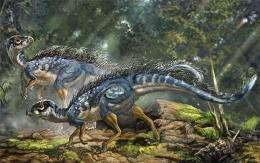Feathers fly over new dinosaur find

The discovery of a petite, plant-eating dinosaur with primitive plumage could mean that the dinosaur from which all others evolved had feather-like protrusions, said a study released Wednesday.
The find in northeastern China is a scientific bombshell, further shattering the once axiomatic view that feathered birds and scaly reptiles developed along different evolutionary paths.
Fossils uncovered in China earlier this decade revealed for the first time feathered dinosaurs older than the winged Archaeopteryx predators -- long assumed to be the first with plumage -- that roamed the Late Jurassic skies some 150 million years ago.
But the new feather-packing dinosaur, dubbed Tianyulong confuciusi, represents an even more radical departure from old paradigms, according to the study, published in the scientific journal Nature.
All dinosaurs fall into one of two large groups that split apart more than 200 million years ago.
The Saurischia group includes the lumbering, long-necked sauropods seen munching tree-tops in the film "Jurassic Park," along with the fearsome Tyrannosaurus rex and all primitive birds, including Archaeopteryx.
The second group, Ornithischia, included armoured dinosaurs such as Tricerotps and Stegosaurus, and was not -- despite the misleading name -- thought to include anything even remotely birdlike.
But Tianyulong, discovered at the Yixian Formation by a team led by Xiao-ting Zhao of the Tianyu Museum of Nature in Shandong Province, falls squarely in this second branch of dinosaur evolution.
This forces paleontologists to ask a fundamental question: Does the presence of proto-feathers on both main branches of dinosaur evolution mean they originated in a common ancestor?
Or did unrelated feather-like appendages -- including those giving rise to modern birds -- appear independently, and at a much later dates, in different groups of dinosaurs over the course of evolution?
The answer depends in part on whether Tianyulong's filament-like proto-feathers grew from inside its skin or on top of it -- whether, in other words, they are dermal or epidermal, notes Lawrence Witmer of Ohio University.
"If they are dermal, then they become interesting but not of monumental importance," he wrote in a commentary, also published in Nature. "If they are epidermal, then they take on great significance."
"The presence of epidermal, feather-like structures could mean that the ancestral dinosaur was a fuzzy (though maybe not a cuddly) animal," he wrote.
Unfortunately, fossil remains probably cannot give a definitive answer, Witmer said.
But they do yield clues. The filaments protruding from Tianyulong were probably hollow rather than solid, which would be consistent with an epidermal structure.
The spines of the feathers were also extremely long at the base of the tail, suggesting they were attached on the surface of the skin.
But "the ultimate question is whether they are part of the evolutionary lineage of true feathers or an independent evolution of projecting epidermal appendages," said Witmer.
For the moment, he concluded, the new addition to the dinosaur family -- while adding important new elements -- "has made an already confusing picture of feather origins even fuzzier."
Tianyulong -- literally, "dragon of the open sky" -- was about 70 centimetres (28 inches) long, more than half of its length taken up by its tail.
(c) 2009 AFP
















